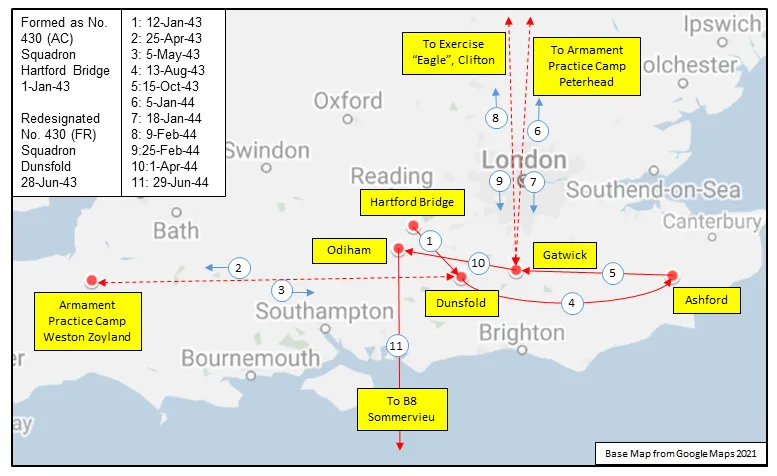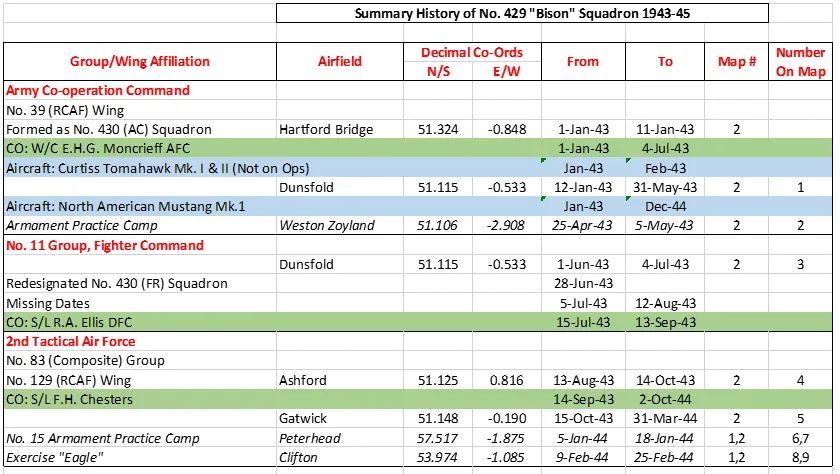(RCAF Photo via Mike Kaehler)(Source Harold A Skaarup Web Page)
North American Mustang Mk. IV, RCAF (Serial No. 9253), coded BA-S,
No. 424 Squadron, Hamilton, Ontario
Chris Charland noted that the Mustang in the forefront is former USAF P-51D (Serial No. 44-74502A).
The North American Aviation P-51 Mustang is an American long-range, single-seat fighter and fighter-bomber used during World War II and the Korean War, among other conflicts. The Mustang was designed in April 1940 by a team headed by James Kindelberger of North American Aviation (NAA) in response to a requirement of the British Purchasing Commission. The Purchasing Commission approached North American Aviation to build Curtiss P-40 fighters under license for the Royal Air Force (RAF). Rather than build an old design from another company, North American Aviation proposed the design and production of a more modern fighter. The prototype NA-73X airframe was rolled out on 9 September 1940, 102 days after the contract was signed, and first flew on 26 October
The Mustang was designed to use the Allison V-1710 engine, which had limited high-altitude performance in its earlier variants. The aircraft was first flown operationally by the RAF as a tactical-reconnaissance aircraft and fighter-bomber (Mustang Mk I). Replacing the Allison with a Rolls-Royce Merlin resulted in the P-51B/C (Mustang Mk III) model, and transformed the aircraft's performance at altitudes above 15,000 ft (4,600 m) (without sacrificing range), allowing it to compete with the Luftwaffe's fighters. The definitive version, the P-51D, was powered by the Packard V-1650-7, a license-built version of the two-speed, two-stage-supercharged Merlin 66, and was armed with six .50 caliber (12.7 mm) AN/M2 Browning machine guns.
Canada had five squadrons equipped with Mustangs during the Second World War. RCAF Nos. 400, 414 and 430 Squadrons flew Mustang Mk. Is (1942"“1944) and Nos. 441 and 442 Squadrons flew Mustang Mk. IIIs and Mk. IVAs in 1945.
Wikipedia and Harold Skaarup web page
 Mustang
Mustang
 Wikipedia Mustang
Wikipedia Mustang
 Harold A Skaarup Web Page
Harold A Skaarup Web Page
430 (F) Sqn Celeriter Certoque ("City of Sudbury")
h4>History of the Squadron during World War II (Aircraft: Tomahawk I, III, Mustang I, Spitfire FR Mk XIV)
[Note that the squadron crest and motto were not given to the squadron until after WWII. During WWII the squadron had neither crest nor motto.] This squadron was the third and last Army Co-operation squadron formed by the RCAF overseas in WWII. It was formed on January 1, 1943 at Hartford Bridge, Hampshire, UK  and was designated Fighter Reconnaissance on June 28, 1943. The squadron carried out photographic reconnaissance for the D-Day invasion planners, and later for the air attacks on the V-1 flying bomb "No-Ball" sites. After the D-Day landings it provided tactical reconnaissance for ground forces in NW Europe. Having been formed as part of No 39 (RCAF) Wing, it joined No 11 Group of Fighter Command in June of 1943, then 2nd Tactical Air Force, No 129 (RCAF) Wing, based at Ashford, Kent
and was designated Fighter Reconnaissance on June 28, 1943. The squadron carried out photographic reconnaissance for the D-Day invasion planners, and later for the air attacks on the V-1 flying bomb "No-Ball" sites. After the D-Day landings it provided tactical reconnaissance for ground forces in NW Europe. Having been formed as part of No 39 (RCAF) Wing, it joined No 11 Group of Fighter Command in June of 1943, then 2nd Tactical Air Force, No 129 (RCAF) Wing, based at Ashford, Kent  and Gatwick, Surrey
and Gatwick, Surrey  . It transferred to No 128 (RCAF) Wing from April to July 1944, during which time it moved to France. From July 1944 to May1945, it was part of No 39 (RCAF) Wing and moved to different bases with the armies as they advanced through France, Belgium, the Netherlands and Germany. The squadron was disbanded at Luneburg, Germany
. It transferred to No 128 (RCAF) Wing from April to July 1944, during which time it moved to France. From July 1944 to May1945, it was part of No 39 (RCAF) Wing and moved to different bases with the armies as they advanced through France, Belgium, the Netherlands and Germany. The squadron was disbanded at Luneburg, Germany  in August of 1945. During its operations, it flew Curtiss Tomahawk Mk I and III (but not on operations) in January and February 1943. From January 1943 it flew North American Mustang Mk I, finally ending up with Spitfire FR Mk XIV aircraft in November 1944.
in August of 1945. During its operations, it flew Curtiss Tomahawk Mk I and III (but not on operations) in January and February 1943. From January 1943 it flew North American Mustang Mk I, finally ending up with Spitfire FR Mk XIV aircraft in November 1944.
The squadron flew 4946 sorties for the loss of 29 aircraft: it destroyed 31 locomotives and other vehicles. It won 9 DFCs, 1 Air Medal (USA) and 1 Croix de Guerre (France). Battle Honours were: Fortress Europe 1943-44, France and Germany 1944-45, Normandy 1944, Arnhem, Rhine.Wikipedia, Kostenuk and Griffin
Maps for Movements of 430 Squadron 1943-45
MAP 1: 430 Squadron Movements in UK 1943-44 (right-click on image to display enlarged in new tab)
|
MAP 2: 430 Squadron Movements in Southern England 1943-44 (detail of Map 1)
|
MAP 3: 430 Squadron Movements in Europe 1944-45
430 Squadron History Summary 1943-45
430 Squadron History Summary 1943-45 Page 2
History of the Squadron Post-WWII (Aircraft: Sabre 2, 5, 6, Starfighter, Twin Huey, Kiowa, Griffon)
The squadron was re-formed as a Fighter unit at North Bay, Ontario  on 1 November 1951. It was given the nickname Silver Falcon. With Sabre aircraft, the squadron joined No. 2 (Fighter) Wing at Grostenquin, France
on 1 November 1951. It was given the nickname Silver Falcon. With Sabre aircraft, the squadron joined No. 2 (Fighter) Wing at Grostenquin, France  in September 1952. Selected as one of eight squadrons in No. 1 Air Division Europe to be re-equipped with CF-104 aircraft for a nuclear strike role, it was deactivated on 1 June 1963 and reactivated as Strike Attack on 30 September. When No. 2 Wing was disbanded on 24 February 1964, the squadron moved to No. 3 Wing at Zweibrucken, Germany
in September 1952. Selected as one of eight squadrons in No. 1 Air Division Europe to be re-equipped with CF-104 aircraft for a nuclear strike role, it was deactivated on 1 June 1963 and reactivated as Strike Attack on 30 September. When No. 2 Wing was disbanded on 24 February 1964, the squadron moved to No. 3 Wing at Zweibrucken, Germany . On 1 February 1968 the squadron was integrated into the Canadian Armed Forces. The squadron moved to 1 Wing Lahr, West Germany
. On 1 February 1968 the squadron was integrated into the Canadian Armed Forces. The squadron moved to 1 Wing Lahr, West Germany  in February 1969 until it was disbanded in May 1970.
in February 1969 until it was disbanded in May 1970.
The unit reformed again in 1971 as a French-language Canadian Forces tactical helicopter squadron at Valcartier  and known officially as 430e Escadron tactique d'hélicoptères. There it operated the Bell CH-136 Kiowa and the Bell CH-135 Twin Huey in support of 5 Canadian Mechanized Brigade Group. The unit transitioned to the CH-146 Griffon in 1994. 430 THS has participated in several international missions, in locations including Haiti, Bosnia-Herzegovina, Kosovo, Afghanistan, Iraq, and Mali.
and known officially as 430e Escadron tactique d'hélicoptères. There it operated the Bell CH-136 Kiowa and the Bell CH-135 Twin Huey in support of 5 Canadian Mechanized Brigade Group. The unit transitioned to the CH-146 Griffon in 1994. 430 THS has participated in several international missions, in locations including Haiti, Bosnia-Herzegovina, Kosovo, Afghanistan, Iraq, and Mali.









